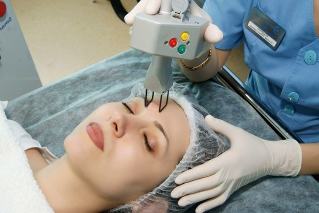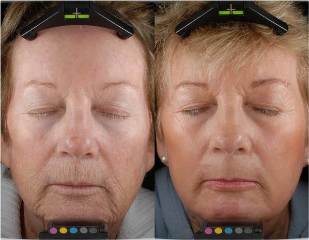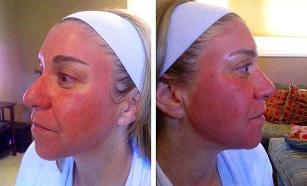
Fractionated CO2 laser is an innovative technology in aesthetic medicine and cosmetology that allows skin to be rejuvenated and smoothed and to get rid of unpleasant appearance defects such as scars, scars, stretch marks.However, its use is highly controversial. There are supporters of this method of skin care, most often among surgeons, and also opponents, represented by dermatologists and cosmetologists.
What is this procedure, what effects does it cause, and why does it cause such conflicting opinions? We will explain everything in detail and answer all your questions.
Fractional laser: description and characteristics of the process
Cosmetology and aesthetic medicine use 2 types of fractional lasers: lower power and shorter wavelength erbium, and CO2 lasers, which use more laser power and reach deeper layers of the skin.
Fractional laser treatment produces the following results:
- Rejuvenation.
- Improving the structure of the epidermis.
- Reduce stretch marks, scars and scars.
- Remove age spots.
- Shrink the pores.
- Skin tightening.
- Adjusts the complexion.
- Rejuvenate the skin by stimulating blood circulation in the capillaries, which gives it more oxygen, which has a positive effect on its appearance.

The most popular is fractional rejuvenation with a CO2 laser, which gives excellent results. Due to the increased production of elastin and collagen, the skin regains its firmness and elasticity, wrinkles are smoothed out and the complexion is evened out. There is a lifting effect that allows the previous contours of the face to return - it becomes clearer and more demarcable, the chin and the sagging of the face cease, the nasolabial folds smooth out.
In the photo, you can compare the patient's skin condition before and after the fractional laser:
The procedure treats the skin with laser beams that work on 20-25% of the treated area when a laser head is activated. The laser beams are spaced at certain distances from each other, both vertically and horizontally. The number of rays and the depth of treatment of the skin tissues depend on the setting of the laser parameters on the particular skin surface and the head used. These are selected depending on the characteristics of the patient's skin, the area of treatment, and the type of problem for which the procedure is performed.
The wavelength of the fractionated laser is about 1550 nm. As a result, the beam penetrates the skin to a depth of 2 mm. It stimulates the production of collagen and elastin in skin tissues, leading to a rejuvenating effect and a reduction in scars and scars. In addition, the procedure increases the regenerative function of the epidermis.
To achieve the desired result, you must go through 2-6 procedures, your doctor will tell you the exact number.The duration of the procedure is 40-100 minutes (processing time depends on many parameters).
Despite the excellent effects, the procedure still causes many negatives, especially among those who were initially poorly informed and frustrated by the discomfort and pain involved in the procedure.
Description of CO2 fractional laser operation
Fractional CO2 laser therapy works very similarly. The main difference is the wavelength around 10, 000 nm.This is an ablative technique used to reduce large scars or age spots and a strong facelift.
The procedure is performed under anesthesia. To do this, an anesthetic cream is applied to the treated area of the skin or painkillers are taken orally.
Despite the pain relief, the patient experiences little comfort while treating the skin with laser beams. The skin becomes swollen, red, and there is a feeling of tightness and dryness, often accompanied by itching. This feeling disappears after about 2 days and is replaced by exfoliation of the epidermis, which can lead to a darker shade of skin color.
Rosacea or redness will not go away completely after about 2 weeks.If the healing period with erbium laser treatment lasts 1-3 days, rehabilitation after CO2 fractionated laser treatment will take 4-7 days.But in most cases, the discomfort is felt for a longer period of time - up to 2 weeks.
It should be noted that 3-6 procedures should be performed every 3-6 weeks to achieve the effect. Results from collagen fiber rearrangement can only be observed 3-6 months after the procedure. Thus, CO2 fractionated laser skin rejuvenation is definitely only suitable for very patient people who are not chasing fast results.
Erbium fractionated laser
The erbium fractionated laser differs from the CO2 laser in lower and shorter radiation - the wavelength is 1064-2940 nm. It is safer and gentler on the skin, and also treats a specific area in a targeted way and does not affect the surrounding tissues.
Used on fine skin parts: neck, arms, décolleté.

Rehabilitation and care after the procedure
The rehabilitation period takes 4-5 days. Immediately after the procedure, the skin may turn red, itchy, flaky and attractive. Therefore, it is advisable to give up important matters in the days following the meeting and spend at home, resting. But keep in mind that all the consequences of the procedure will completely disappear after about 2 weeks.
Post-procedure skin care plays an important role in the fractional laser result.If you want it to look good, you need to pay special attention to it in the first days after the procedure. Optimal moisture levels must be ensured. After the procedure, your doctor will give you advice on moisturizers to use after the procedure.
It is important to note that sunlight should be avoided in the first days after a session as it can have a destructive effect on new cells and discolor the skin. During the first month you should not take a hot bath, visit a sauna, swimming pool, swim in open water, sunbathe purposefully.
Another guideline after treatment is to allow the skin to regenerate at its own pace. Do not specifically increase skin exfoliation, tear off flaky areas - this can lead to a completely opposite effect than expected.
What are the indications and contraindications for CO2 fractionated laser
The main indications for this procedure are:
- Skin looseness.
- Age-related changes.
- Deterioration of facial contours.
- Wrinkles.
- Enlarged pores.
- Scars, stretch marks, acne.
- Pigmented spots.
- Reduces skin firmness.
- Benign formations.
Here are the contraindications to fractional laser:
- Pregnancy.
- Cancer.
- Inflammation.
- Skin infections.
- Psoriasis.
- Fresh tan.
- Chronic diseases in the acute stage.
- Oncology.
- Diabetes mellitus.
- Clock inclination.
- Thrombosis.
Taking into account all the advantages and disadvantages, it should be emphasized that the treatment with fractional laser is only after consultation with your doctor and after being thoroughly informed about the procedure.You should be fully aware of what awaits you during the session and how well you will be able to correct skin blemishes.
We assume that the procedure is inconvenient and even painful, despite the use of painkillers, and the result will not appear until a few months later. Therefore, it is not suitable for impatient and people with low pain thresholds. Given the high cost of the procedure (depending on the area being treated and the pricing policy of the cosmetology center), the decision only needs to be made after careful consideration of everything.
CO2 fractionated laser reviews
Most opinions on the fractional laser process are positive. Those who have made it note its high effectiveness: it removes scars and scars, smoothes the skin, improves skin relief and texture, reduces pigmentation and evens out complexion. But the praise is at the same time parallel to complaints. The very high price, the pain of the procedure, the long wait for the results, the severe itching and redness after the session - these are the moments that cause dissatisfaction among the patients.
It should be borne in mind that the effect depends largely on the professionalism of the person performing the procedure. Therefore, if you decide to use a fractionated laser to refresh or rejuvenate your skin, be very careful when choosing a beautician. If you consult an inexperienced doctor, it can have the exact opposite effect than expected - instead of repairing the skin, it worsens and takes a long time to treat.























